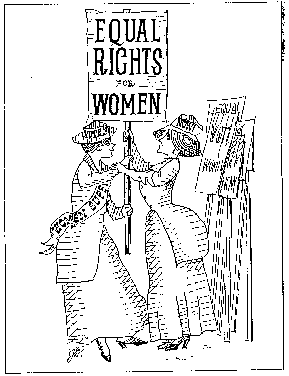
Volume 3 Number 5
Women Win Right to Vote!
U. S. A. August 26, 1920
Amendment Ratified Last state needed to pass finally acts Tennessee Legislature Passes by One Vote
It Started in Seneca Falls, New York Blame it on Elizabeth Cady Stanton
and Lucretia MottAfter 72 years of concerted steady effort by women and their fair-minded men allies, the right to vote along side their brothers is finally granted! It is a tragedy that women such as Alice Paul had to be jailed and suffer untold indignities to gain the attention of the nation, but the fight to win the vote was becoming desperate and women were tiring of the long battle.
What began innocently at a tea party in Seneca Falls, N. Y. as a plan to gain political and societal rights afforded to even the poorest of men in 1848 has now found what then seemed to be the boldest of the women’s demands made into a reality: the right to vote.
When Elizabeth Cady Stanton and Lucretia Mott first met in London while accompanying their husbands to the first World Anti-Slavery Convention, they were refused a place in the hall, instead they were seated behind a grille, and were refused, as was customary at the time, a chance to speak.
It would be eight years before they would meet again. That day in July 1848, Mott and Stanton hastily organized the first Woman’s Rights Convention to be held on July 19 and 20 at the Wesleyan Chapel in Seneca Falls.
The first day, men would be refused entrance while the women discussed and amended a Declaration of Sentiments and 11 Resolutions which had been written up by the organizers. The next day the doors were opened to men, many of them well-known and respected.
Among the men, Frederick Douglass, a freed slave and self-taught publisher, spoke in favor of the women's resolutions. A total of 100 persons signed the document: 68 women and 32 men. The 9th Resolution, written by Stanton, regarding the right to vote, was nearly voted down. But, with the help of Douglass and Stanton's own inspirational oratory, the Resolution passed!
The stir that these women caused would not be known for a while, but their boldness was seen as revolutionary and "radical" according to the The Seneca County Courier which carried a story in their paper the day following the convention and published the sentiments and resolutions in their number published on Aug. 4th.
This convention was novel in its character, and the doctrines broached in it are startling to those who are wedded to the present usages and laws of society. The resolutions are of the kind called radical. Some of the speeches were very able, all the exercises were marked by great order and decorum. When the Declaration of Sentiments (fashioned after the American Declaration of Independence) and Resolutions shall be printed and circulated, they will provoke much remark. Some will regard them with respect, others with ... contempt.
Many of the women attending were active in the anti-slave movement and born into the Quaker religion which allowed their women a little more voice than many mainstream religions of the day. One of the major factors that made these Resolutions so difficult to carry out was that women, as a rule, were not allowed to speak at a public forum.
Another movement that was gathering support at the time was the temperance movement. Out of this movement, another Quaker woman would soon join the ranks of the woman’s movement, but only after great encouragement from E. Cady Stanton. This new strong ally would become one of the most famous of the movement even though she was not convinced at first that she should spend her time and energy on such a project. Susan B. Anthony would become a life-long friend and Stanton supporter. They published a newspaper Revolution for a while which called for equality of the sexes, temperance and fair divorce laws. Anthony was arrested and then put on trial for voting illegally in the 1872 election, although she lost the case, she won national support for women’s rights.
Anthony traveled all over the United States, including trips to the Northwest where Abigail Scott Duniway accompanied her many places, to lecture on the rights and plights of women. Her temperance ideas were opposite of Duniway’s, but they agreed on the main topic — woman’s suffrage, so Duniway stuck it out and carried many letters from Anthony in her newspaper, the New Northwest.
Since newspapers and lecture circuits were the only real way of getting one’s message out, many different suffrage newspapers were needed. No TV, Radio or Internet then. But, it seemed that as soon as one would go out of business, usually bankrupted, (Anthony assumed a $10,000 debt from the Revolution) another would rise to take its place.
The main topic always included the topic of voting rights, but their other leanings might be totally opposite. While Anthony was true Temperance, Duniway was against trying to legislate morality. Another early publisher sought to simplify woman’s clothing and free her body as well as mind:
Amelia Bloomer, publisher Promotes Sensible Fashion, Temperance in her newspaper A monthly Journal The Lily is Devoted to the Emancipation of Woman from Intemperance, Injustice, Prejudice and Bigotry Between 1851 and 1854, Lucy Stone, Elizabeth Cady Stanton, Susan B. Anthony and others of the women’s rights movement followed Bloomer’s fashion ideas about women’s clothing and adopted the Bloomers as their attire, only to be treated with contempt wherever they went: jeered at in the streets and criticized from the pulpit. They continued as long as they could bear the public condemnation. It essentially made them ineffectual because their lectures would be continuously interrupted with snide remarks.
The August 1852 number of The Lily, carried an address from the Woman’s Rights Convention that had been held that year in Worchester, Pa., given by Miss Ann Preston. Here is a small quote:
We place not the interests of woman in antagonism to that of her brother, for ‘The woman’s cause is man’s; They rise or sink together; Dwarfed or God-like, bond or free.’...We ask for her, as for man, equality before the law, and freedom to exercise all her powers and faculties under the direction of her own judgment and volition.
The struggle to raise people’s awareness to the plight of women became more intense. The suffragists pointed out many injustices: taxation without representation (women paid taxes, but could not vote); the disgrace that widows experienced after their husbands died was not ever experienced by the man (children could be taken by the state with no regard for the mother’s wishes and the state could seize property since women could not legally own property in many states); and, divorces were difficult, if not impossible to obtain, when requested by women. It became apparent that men needed to speak up for their own daughters’ future, if not for their own wife. The question that became resounding, How long must we wait for freedom? was repeated by speakers at every opportunity. The length of time one had to wait depended upon in which state you lived.
Wyoming Gives Women Suffrage When Becoming a Territory - 1869 The Westward movement that had already begun when Mott and Stanton organized the first Women’s Rights Convention in 1848 was to change the scene of politics forever. Women were in great demand in the West and even the lowliest women were treated with respect to encourage them to stay on the frontier.
In Wyoming, Esther Morris, a milliner from New York who followed Anthony's philosophy, managed to convince the territorial legislature that women could help establish law and order if they had the vote. This one woman, at a tea party in her frontier home, convinced these men that it would benefit them to enfranchise women. The battle there was won without a fight.
In 1890, when Wyoming entered the Union as a state, it became the first woman's suffrage state. Colorado soon followed in 1893. Utah became the third state to join the suffragist states in 1896. Idaho gave women the vote the same year Utah entered the Union. The victory in Colorado and Idaho was won primarily by the efforts of Carrie Chapman Catt (founder of League of Women Voters) who taught women how to lobby and organize. ---Bridget E. Smith, Historical Gazette
This story is from the front page of this edition which was published to commemorate the 75th Anniversary of Woman's Suffrage. It was distributed free on August 26th, 1995 in downtown Portland at the march and event held as part of the celebration. More than 1500 women and men marched in this parade, as did the editor of the Historical Gazette. Read more from this issue and learn about the Oregon suffrage pioneer: Abigail Scott Duniway. In 2001, we were contacted by the authors of an educational English book. I was asked to grant them permission to use my Women Win The Right To Vote article in their book as a way of teaching their classroom. I sold them the rights for a nice price. Not too much for them, and just right for me as I always needed money for my next project. It made me feel good that they wanted to use my work. It's been so long now that I doubt if it's still being used in class. I own one copy that they sent me as a proof.
Here's an image of the book cover.
Mastering FCAT Reading Grade 10
8 1/2" x 11" 304 p. softbound © 2002


